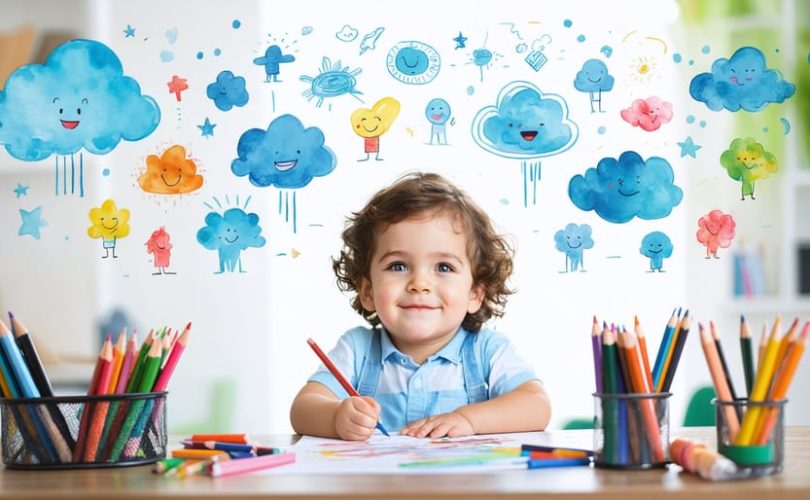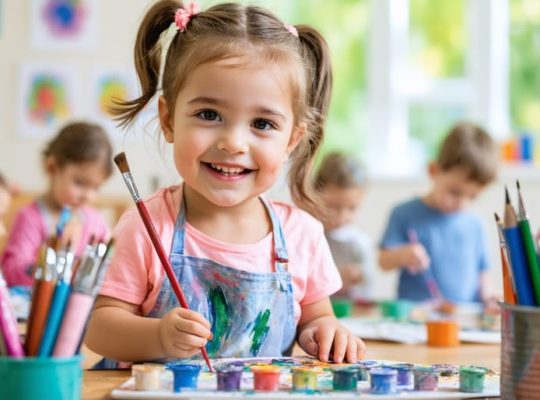Visual storytelling empowers children to express complex emotions and experiences when words alone fall short. Through carefully structured art activities, drawing exercises, and visual narratives, children naturally align with their child developmental stages while processing challenging experiences or transitions.
This therapeutic approach bridges the gap between a child’s inner world and their ability to communicate effectively with parents, teachers, and mental health professionals. Whether using simple stick figures, elaborate paintings, or even digital tools, visual storytelling provides a safe, non-threatening medium for children to share their stories and work through difficult emotions.
Research shows that when children engage in visual storytelling, they demonstrate improved emotional regulation, enhanced self-awareness, and stronger communication skills. This creative process allows them to externalize their experiences, making abstract feelings concrete and manageable. By combining artistic expression with gentle guidance, caregivers can help children develop resilience while honoring their unique perspectives and experiences.
As we explore various visual storytelling techniques, remember that every child’s journey is unique. The goal isn’t artistic perfection but creating a supportive space where children feel empowered to express themselves authentically and work toward emotional well-being.
Why Visual Storytelling Works for Children
The Brain-Art Connection
When children engage in visual expression, something remarkable happens in their brains. Research shows that drawing, painting, and other forms of visual storytelling activate different neural pathways than speaking or writing. This unique brain engagement is one of the key benefits of art therapy and visual communication.
The right hemisphere of the brain, which processes emotions and visual information, becomes particularly active during artistic expression. This explains why children often find it easier to draw their feelings rather than verbalize them. Dr. Sarah Chen, a pediatric neurologist, explains, “When children create art, they’re actually accessing memories and emotions that might be difficult to express through words alone.”
Brain imaging studies have shown that visual storytelling engages multiple areas simultaneously – from the visual cortex to the emotional centers of the limbic system. This multi-region activation helps create stronger neural connections and can lead to better emotional processing and memory formation. For children who have experienced trauma or struggle with verbal expression, this alternative pathway of communication can be particularly healing and empowering.
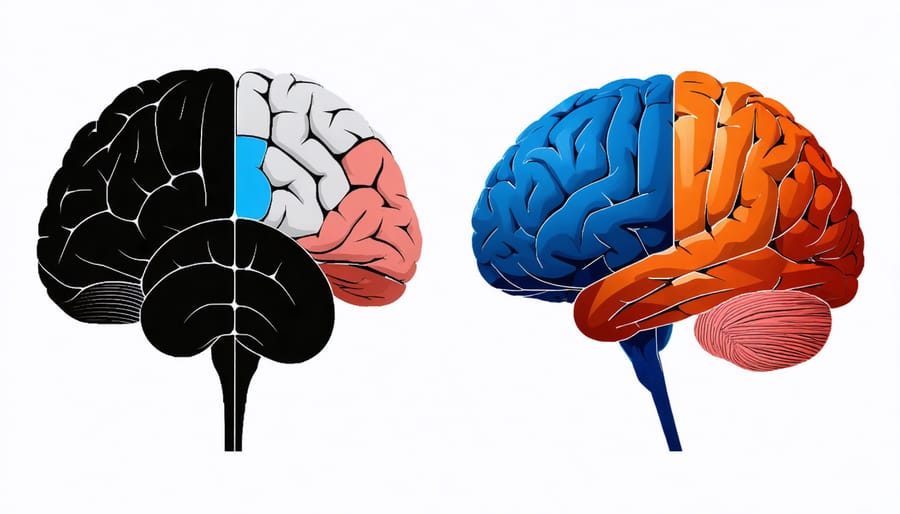
Breaking Through Communication Barriers
For children who struggle with verbal expression, visual storytelling opens up powerful new channels of communication. Through drawing, collage, or digital art, children can share their experiences and emotions in ways that feel safer and more natural than speaking. As art therapist Maria Chen explains, “When words feel too big or scary, pictures can become a child’s voice.”
Visual storytelling bypasses the pressure of finding the right words, allowing children to express complex feelings through colors, shapes, and symbols. A child who finds it difficult to say “I’m worried about starting a new school” might draw themselves as a small figure surrounded by tall buildings, instantly conveying their feelings of uncertainty and overwhelm.
This approach is particularly beneficial for children with autism, anxiety, or trauma experiences. Through visual narratives, they can process their experiences at their own pace and maintain control over their story. Parents and therapists often report breakthrough moments when children use art to share thoughts and feelings they’ve never verbalized before.
The beauty of visual storytelling lies in its accessibility – there’s no “right” way to tell a story through pictures, making it a judgment-free zone for self-expression.
Essential Visual Storytelling Techniques
Drawing and Coloring Stories
Drawing and coloring offer children a natural and enjoyable way to express their stories and emotions. Simple art supplies like crayons, colored pencils, and paper can become powerful tools for storytelling, allowing children to communicate experiences they might find difficult to put into words.
Start by creating a comfortable, judgment-free space where children feel safe to express themselves. Provide a variety of art materials and let them choose what feels right for their story. Some children might prefer bright markers for happy memories, while others might choose softer colors for gentler emotions.
Encourage children to draw their story in sequential panels, like a comic strip, or create a single detailed picture that captures an important moment. You might prompt them with gentle questions like “What happened first?” or “Who else was there?” but allow them to lead the narrative.
As they draw, pay attention to their color choices and the elements they emphasize. These details often reveal important aspects of their experience. Some children might make certain figures larger or smaller, use particular colors repeatedly, or focus on specific details – all of which can provide insight into their perspective.
Remember that the goal isn’t to create perfect artwork but to facilitate expression and communication. Praise their effort and show genuine interest in their story rather than focusing on artistic skill. This approach helps build confidence and encourages continued self-expression through art.
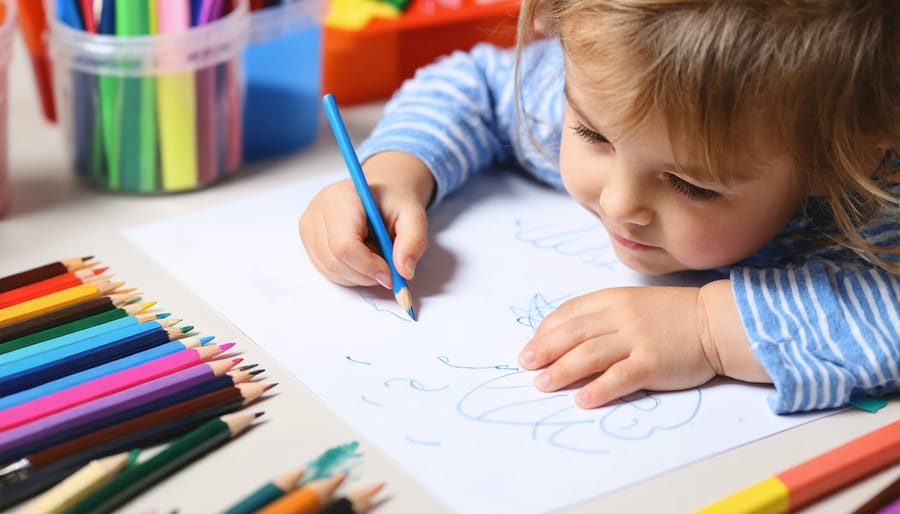
Photo Journaling
Photo journaling combines the power of photography with personal reflection, creating a compelling way for children to share their experiences and emotions. When children capture moments through their own lens, they often feel more comfortable expressing feelings that might be difficult to put into words alone.
To start photo journaling, encourage children to take pictures of things that matter to them – their favorite toys, special places in their home, or moments with family members. These photographs become conversation starters, allowing children to tell their stories naturally and at their own pace.
Parents and caregivers can guide children by asking gentle, open-ended questions about their photos: “What made you want to take this picture?” or “How did you feel when this was happening?” These questions help children develop their narrative voice while processing their experiences.
One particularly effective approach is creating themed photo collections. For instance, children might collect images that make them feel happy, safe, or brave. This helps them identify and express their emotions while building a visual vocabulary for their feelings.
Remember to keep the activity relaxed and enjoyable. There’s no “right” way to photo journal – some children might want to write captions, others might prefer to tell their stories verbally, and some might let their pictures speak for themselves. The goal is to provide a safe, creative space for self-expression and emotional exploration.
Digital Story Creation
In today’s digital age, children have access to numerous creative expression tools that make visual storytelling both engaging and therapeutic. For younger children (ages 4-7), apps like Story Creator and Draw and Tell HD offer simple interfaces with voice recording capabilities, allowing them to combine drawings with narration. These apps help children who might struggle with traditional verbal expression to share their thoughts and feelings through pictures and sound.
For older children and teens (ages 8-15), platforms like Storybird and Comic Life provide more sophisticated storytelling options. These tools allow them to create detailed narratives using professional artwork or their own photos, helping them explore complex emotions through visual metaphors and character development.
When selecting digital storytelling tools, look for:
– Age-appropriate content and controls
– Simple, intuitive interfaces
– Options to save and share stories
– The ability to combine different media types
– Privacy features to protect children’s work
Popular free options include Book Creator (for tablets) and Toontastic 3D, which lets children create animated stories while developing emotional awareness. Remember that digital tools should complement, not replace, traditional art materials and face-to-face storytelling activities. The goal is to provide multiple channels for self-expression, allowing children to choose the medium that feels most comfortable for them.
Supporting Your Child’s Visual Expression
Creating Safe Spaces
A nurturing environment is essential for children to feel comfortable expressing themselves through visual storytelling. As Maria Thompson, a child art therapist with 15 years of experience, explains, “When children feel safe and supported, their creative expression flows naturally.” Creating therapeutic spaces begins with setting up a physically comfortable area where children can work without interruption or judgment.
Start by designating a quiet corner or room with good lighting and comfortable seating. Ensure all necessary art supplies are easily accessible and organized. Having materials ready shows children you value their creative process and encourages spontaneous expression.
Emotional safety is equally important. Establish clear guidelines that promote respect and acceptance. Simple rules like “there’s no right or wrong way to tell your story” and “we don’t criticize others’ artwork” help children feel secure in sharing their experiences.
Remember to validate children’s efforts without focusing on artistic merit. Instead of saying “that’s beautiful,” try “tell me about your story” or “what inspired you to choose those colors?” This approach encourages deeper engagement and reinforces that their thoughts and feelings matter more than artistic perfection.
Create predictable routines around visual storytelling sessions. Starting with a brief mindfulness exercise or gentle warm-up activity can help children transition into a creative mindset while feeling grounded and present.
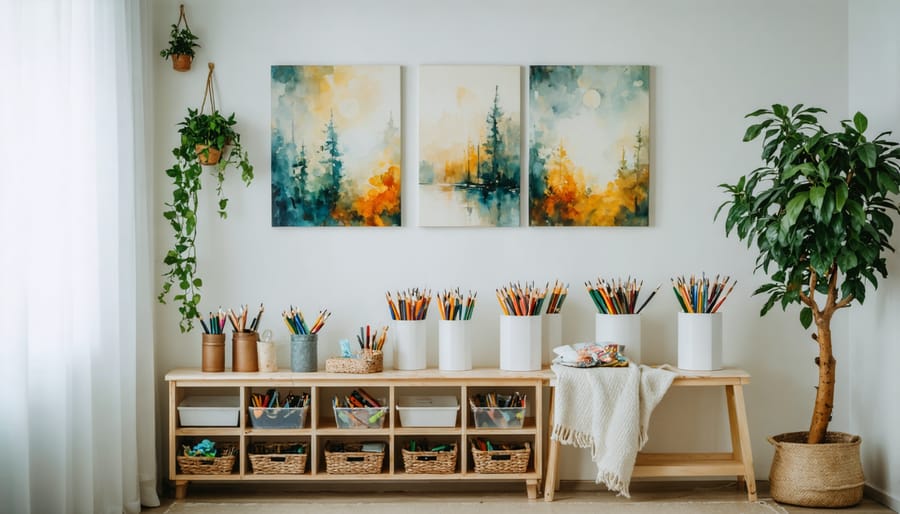
Responding to Visual Stories
When children share their visual stories, our response can either encourage or inhibit their future self-expression. The key is to create a safe, supportive environment where they feel heard and validated. Start by giving them your full attention and showing genuine interest in their artwork.
Rather than making assumptions or jumping to interpretations, ask open-ended questions like “Can you tell me about your drawing?” or “What’s happening in this part of your story?” This approach empowers children to be the experts of their own narratives and helps them feel in control of their storytelling experience.
Validate their emotions and experiences by reflecting what you hear. For example, if a child draws a scene about feeling lonely at school, you might say, “It sounds like that was a really hard day for you” instead of trying to immediately fix the situation or dismiss their feelings.
Remember to praise their effort and creativity rather than focusing solely on the artistic quality. Comments like “I can see how much thought you put into this” or “You used such interesting colors to show those feelings” encourage continued expression.
If a child seems hesitant to explain their work, respect their boundaries. Sometimes simply sitting together quietly while they draw can be just as meaningful as discussion. The goal is to make them feel supported and understood in their visual expression.
Visual storytelling is a powerful tool that can transform the way we connect with children and help them process their emotions and experiences. Throughout this journey, we’ve explored various techniques that make storytelling more engaging, meaningful, and therapeutic for young minds. By incorporating visual elements into narrative therapy, we create safe spaces where children can express themselves freely and develop crucial emotional skills.
The beauty of visual storytelling lies in its versatility and accessibility. Whether you’re a parent drawing simple stick figures with your child, a teacher using picture books to discuss complex emotions, or a therapist implementing structured art therapy techniques, these methods can be adapted to suit various needs and situations. The combination of verbal and visual expression allows children to communicate in ways that words alone sometimes cannot.
Remember that success in visual storytelling doesn’t require artistic expertise. What matters most is creating an environment where children feel comfortable sharing their stories and emotions through visual means. Even simple drawings, collages, or digital illustrations can become powerful vehicles for self-expression and healing.
As you begin implementing these techniques, start small and be patient. Let children lead the way in their creative expression while providing gentle guidance and support. Celebrate their efforts and show genuine interest in their visual narratives. Over time, you’ll likely notice improvements in their emotional awareness, communication skills, and ability to process challenging experiences.
The impact of visual storytelling extends far beyond the immediate therapeutic setting. These skills become valuable tools that children can carry with them throughout their lives, helping them understand and express their emotions, solve problems, and build stronger relationships with others.
We encourage you to take that first step today. Whether it’s sitting down with a child to draw together or incorporating visual elements into your professional practice, remember that every creative journey begins with a single mark on the page.

